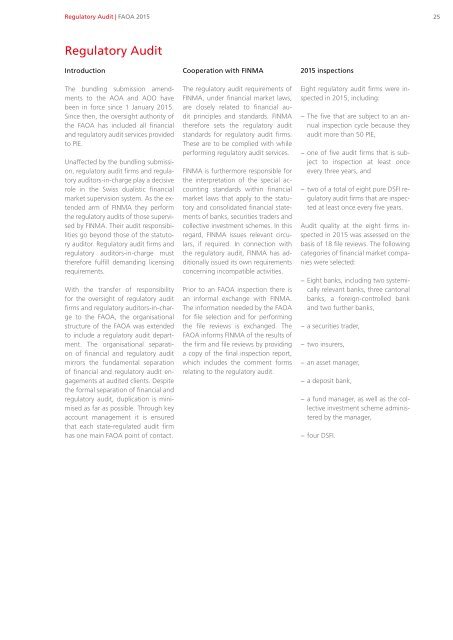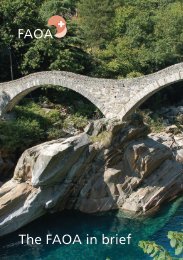Activity Report 2015
Activity Report 2015 - Federal Audit Oversight Authority FAOA
Activity Report 2015 - Federal Audit Oversight Authority FAOA
You also want an ePaper? Increase the reach of your titles
YUMPU automatically turns print PDFs into web optimized ePapers that Google loves.
Regulatory Audit | FAOA <strong>2015</strong><br />
25<br />
Regulatory Audit<br />
Introduction<br />
The bundling submission amendments<br />
to the AOA and AOO have<br />
been in force since 1 January <strong>2015</strong>.<br />
Since then, the oversight authority of<br />
the FAOA has included all financial<br />
and regulatory audit services provided<br />
to PIE.<br />
Unaffected by the bundling submission,<br />
regulatory audit firms and regulatory<br />
auditors-in-charge play a decisive<br />
role in the Swiss dualistic financial<br />
market supervision system. As the extended<br />
arm of FINMA they perform<br />
the regulatory audits of those supervised<br />
by FINMA. Their audit responsibilities<br />
go beyond those of the statutory<br />
auditor. Regulatory audit firms and<br />
regulatory auditors-in-charge must<br />
therefore fulfill demanding licensing<br />
requirements.<br />
With the transfer of responsibility<br />
for the oversight of regulatory audit<br />
firms and regulatory auditors-in-charge<br />
to the FAOA, the organisational<br />
structure of the FAOA was extended<br />
to include a regulatory audit department.<br />
The organisational separation<br />
of financial and regulatory audit<br />
mirrors the fundamental separation<br />
of financial and regulatory audit engagements<br />
at audited clients. Despite<br />
the formal separation of financial and<br />
regulatory audit, duplication is minimised<br />
as far as possible. Through key<br />
account management it is ensured<br />
that each state-regulated audit firm<br />
has one main FAOA point of contact.<br />
Cooperation with FINMA<br />
The regulatory audit requirements of<br />
FINMA, under financial market laws,<br />
are closely related to financial audit<br />
principles and standards. FINMA<br />
therefore sets the regulatory audit<br />
standards for regulatory audit firms.<br />
These are to be complied with while<br />
performing regulatory audit services.<br />
FINMA is furthermore responsible for<br />
the interpretation of the special accounting<br />
standards within financial<br />
market laws that apply to the statutory<br />
and consolidated financial statements<br />
of banks, securities traders and<br />
collective investment schemes. In this<br />
regard, FINMA issues relevant circulars,<br />
if required. In connection with<br />
the regulatory audit, FINMA has additionally<br />
issued its own requirements<br />
concerning incompatible activities.<br />
Prior to an FAOA inspection there is<br />
an informal exchange with FINMA.<br />
The information needed by the FAOA<br />
for file selection and for performing<br />
the file reviews is exchanged. The<br />
FAOA informs FINMA of the results of<br />
the firm and file reviews by providing<br />
a copy of the final inspection report,<br />
which includes the comment forms<br />
relating to the regulatory audit.<br />
<strong>2015</strong> inspections<br />
Eight regulatory audit firms were inspected<br />
in <strong>2015</strong>, including:<br />
− The five that are subject to an annual<br />
inspection cycle because they<br />
audit more than 50 PIE,<br />
− one of five audit firms that is subject<br />
to inspection at least once<br />
every three years, and<br />
− two of a total of eight pure DSFI regulatory<br />
audit firms that are inspected<br />
at least once every five years.<br />
Audit quality at the eight firms inspected<br />
in <strong>2015</strong> was assessed on the<br />
basis of 18 file reviews. The following<br />
categories of financial market companies<br />
were selected:<br />
− Eight banks, including two systemically<br />
relevant banks, three cantonal<br />
banks, a foreign-controlled bank<br />
and two further banks,<br />
− a securities trader,<br />
− two insurers,<br />
− an asset manager,<br />
− a deposit bank,<br />
− a fund manager, as well as the collective<br />
investment scheme administered<br />
by the manager,<br />
− four DSFI.
















